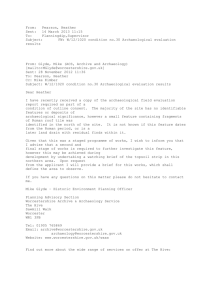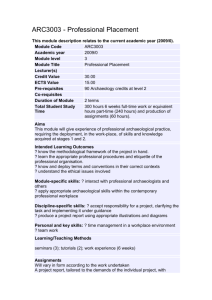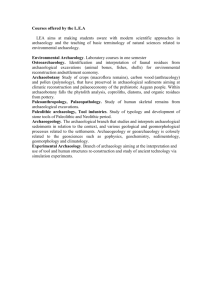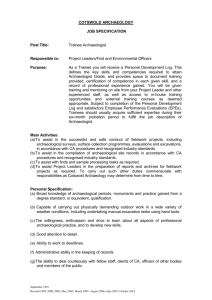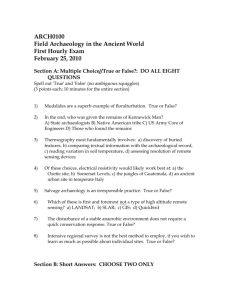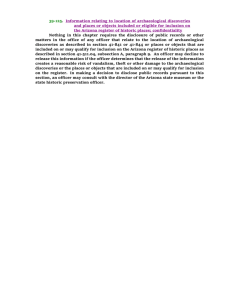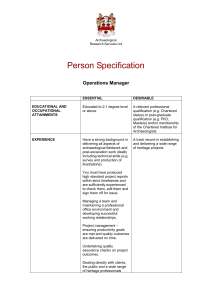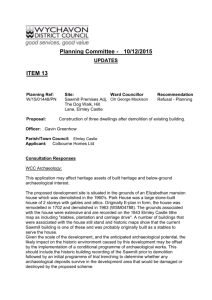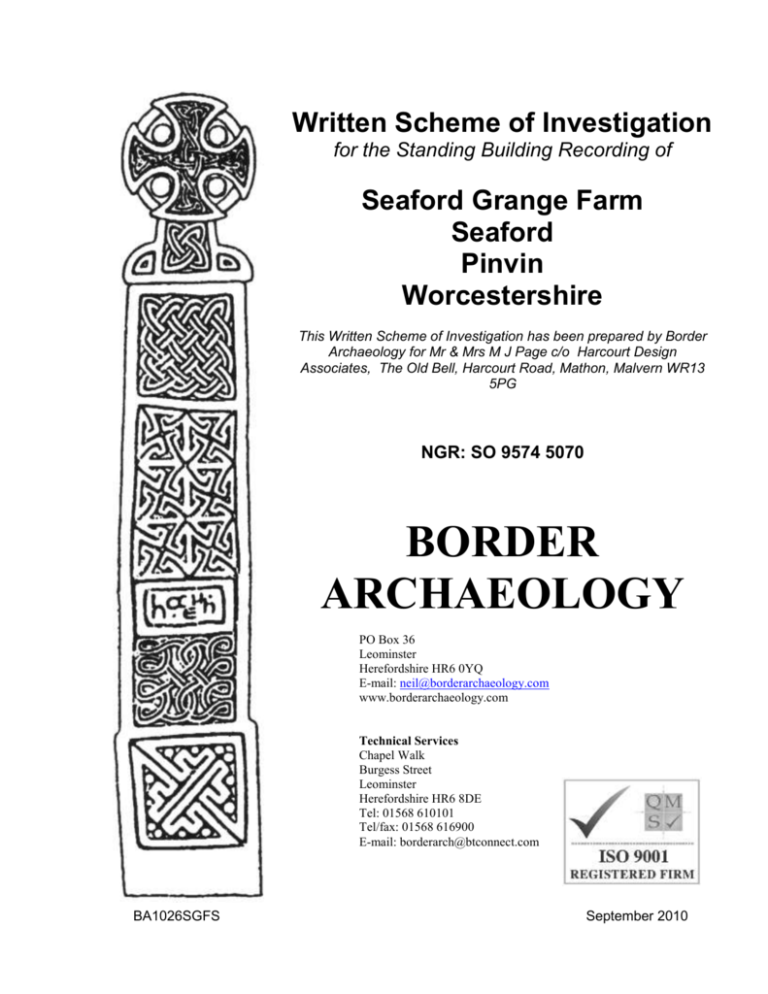
Written Scheme of Investigation
for the Standing Building Recording of
Seaford Grange Farm
Seaford
Pinvin
Worcestershire
This Written Scheme of Investigation has been prepared by Border
Archaeology for Mr & Mrs M J Page c/o Harcourt Design
Associates, The Old Bell, Harcourt Road, Mathon, Malvern WR13
5PG
NGR: SO 9574 5070
BORDER
ARCHAEOLOGY
PO Box 36
Leominster
Herefordshire HR6 0YQ
E-mail: neil@borderarchaeology.com
www.borderarchaeology.com
Technical Services
Chapel Walk
Burgess Street
Leominster
Herefordshire HR6 8DE
Tel: 01568 610101
Tel/fax: 01568 616900
E-mail: borderarch@btconnect.com
BA1026SGFS
September 2010
Seaford Grange Farm, Seaford, Pinvin, Worcestershire
Contents
1.
INTRODUCTION ........................................................................................... 3
2.
PROJECT AIM .............................................................................................. 3
3.
SCHEME OF WORKS ................................................................................... 3
4.
ARCHIVE COMPILATION & ASSESSMENT ............................................... 4
5.
THE REPORT................................................................................................ 5
6.
STAFF & TIMESCALES................................................................................ 5
7.
BORDER ARCHAEOLOGY OPERATING STANDARDS ............................ 6
8.
COPYRIGHT ................................................................................................. 6
9.
MONITORING ............................................................................................... 6
10.
REFERENCES........................................................................................... 7
11.
APPENDIX 1: STATEMENT OF EXPERIENCE ........................................ 8
Border Archaeology - Written Scheme of Investigation
2
Seaford Grange Farm, Seaford, Pinvin, Worcestershire
1.
Introduction
1.1
Border Archaeology has been instructed by Mr & Mrs M J Page, to undertake a
Building Recording programme at Seaford Grange Farm, Seaford, Pinvin,
Worcestershire (WSMR Ref. 41655), regarding a planning application
approved by Wychavon District Council for conversion of a traditional farm
building to two holiday units and one live/work unit, with the condition, in order
to comply with PPS5 Policy HE12, that ‘no development shall take place until
the applicant has secured the implementation of a programme of historic
building recording and interpretation, in accordance with a written scheme of
investigation which has been submitted by the applicant and approved by the
Planning Authority’ (Planning Reference no W/10/0397 condition no.3).
1.2
This Proposal has thus been prepared by the company’s General Manager
George Children MA MIfA and Stephen Priestley MA Research Manager for
submission to Mike Glyde Esq., Historic Environment Planning Officer, Historic
Environment & Archaeology Service, Worcestershire County Council, as a
methodology for the archaeological programme of work, with reference to the
brief detailing Requirements for Historic Building Recording Work at Seaford
Grange Farm issued on July 6th 2010 by M. Glyde, Historic Environment
Planning Officer (Ref. W/10/0397).
2.
Project Aim
2.1
The completion to RCHME Level 3 of a historic building recording survey of
Seaford Grange Farm, Seaford, Pinvin as defined within Understanding
Historic Buildings - A guide to good recording practice (English Heritage, 2006).
3.
Scheme of works
3.1
The aim of the programme of archaeological building investigation and
recording is to allow for the preservation by record of all standing building fabric
of historical interest that will be destroyed or substantially altered by the
development.
3.2
The programme of standing building recording will be carried out in accordance
with the Requirements and Guidelines for Archaeological Projects in
Worcestershire. Border Archaeology adheres to the Institute of Field
Archaeologists Code of conduct and Code of approved practice for the
regulation of contractual arrangements in field archaeology. The recording
programme will adhere to guidelines set out within Planning Policy Guidance
(PPG) 15, Standard and Guidance for the archaeological investigation and
recording of standing buildings or structures (Institute of Field Archaeologists,
1996, revised 2001) and standards defined by English Heritage/RCHME in
Border Archaeology - Written Scheme of Investigation
3
Seaford Grange Farm, Seaford, Pinvin, Worcestershire
Understanding Historic Buildings – A guide to good recording practice (English
Heritage, 2006).
3.3
Primary and secondary documentary sources (where applicable) will be used in
order to assess the historic importance of the building(s). Building phases will
be established prior to the photographic recording of the building, with each
phase being discussed in detail.
3.4
The building survey programme will be carried out to RCHME Level 3(as
stipulated in the brief (Ref. W/10/0397)) combining a written, drawn and
photographic record of all standing walls likely to be affected by the proposed
development. This includes a written description of original features and a
photographic survey of all significant internal and external features (including
all door and window openings and external elevations).
3.5
Full written, graphic and photographic records will be made using pro-forma
record forms and sheets, these being in accordance with Border Archaeology's
Site Recording Manual.
3.6
The written record will include a full description of the structure and provide
details of type, dimensions, form, position of entrance, construction materials,
details of topographical position, deterioration or damage and overall condition.
Additional details, such as the presence of contemporary graffiti, may also form
part of the written record.
3.7
All archaeological record drawings will be prepared to a suitable scale.
Sufficient external and internal measurements will be taken to ensure an
accurate record. A scaled plan and elevations of the farm buildings will be
produced.
3.8
The photographic record will be made using a high-resolution colour digital
camera of 12MP capacity. Individual features will be photographed as separate
items and in detail. Each feature will also be photographed and placed into a
wider context (i.e. the surrounding elevation).
4.
Archive Compilation & Assessment
4.1
All records created during fieldwork will be checked for consistency and
accuracy. All primary fieldwork documentation and records will be preserved
and will form part of the site archive, archive consolidation being undertaken
immediately following the conclusion of fieldwork.
4.2
The site archive will contain all data collected, including records, drawings and
photographs, It will contain, where relevant, the following elements (as detailed
in Management of Archaeological Projects (EH MAP2) Appendix 3):
Copies of correspondence relating to fieldwork
Survey reports (e.g. borehole, geophysical, documentary)
Site notebooks/diaries
Border Archaeology - Written Scheme of Investigation
4
Seaford Grange Farm, Seaford, Pinvin, Worcestershire
Original photographic records
Site drawings (plans, sections, elevations)
Original context records
Artefacts, ecofacts and any other sample residues
Original finds records (e.g. registered finds, bulk finds, artefact dating
catalogues)
Records of conservation and x-rays undertaken during fieldwork
Computer discs and printout
4.3
The archive will be quantified, ordered and internally consistent. Indexing will
include a plan showing the location and reference number of sections and,
where practicable, photograph locations or directions of view. The archive will
be assembled in accordance with the guidelines published in Guidelines for the
preparation of excavation archives for long-term storage (United Kingdom
Institute for Conservation, 1990) and Standards in the museum care of
archaeological collections (Museums & Galleries Commission, 1994).
4.4
Border Archaeology undertakes that the following issues will be addressed and
concluded to the satisfaction of M Glyde Esq:
The written, drawn and photographic records will be of sufficient quality to
facilitate publication in an appropriate specialist journal
Data concerning complete identifiable and itemized objects will be
transferred to specified object record sheets
4.5
In line with OASIS (Online Access to the Index of Archaeological Investigations)
requirements, Border Archaeology will complete an OASIS data capture form
on completion of each report stage and on deposition of the final archive.
5.
The Report
5.1
The Report will clearly and accurately incorporate information gained from the
building recording and from the assessment of primary and secondary
documentary sources.
5.2
The Report will contain a full site plan showing the location of all recorded
features etc as well as profiles, detailed drawings and a comprehensive
photographic record.
5.3
Copies of the Report will be sent to the client, Mike Glyde and the
Worcestershire Historic Environment Record.
6.
Staff & Timescales
6.1
All site investigation and recording will be carried out by Border Archaeology’s
qualified field staff. The project will be undertaken by Stephen Priestley MA,
who has extensive experience in both undertaking and reporting on Standing
Border Archaeology - Written Scheme of Investigation
5
Seaford Grange Farm, Seaford, Pinvin, Worcestershire
Building Recording Surveys, with the assistance of William Logan BA Dip and
Ross Shurety BA (Cantab.) who have also previously worked on historic
building recording projects (a statement of Stephens’s relevant experience is
supplied in Appendix 1).
6.2
It is estimated that the building survey will take four days to complete. Should
further time be required due to adverse weather or access problems, provision
has been made for two additional days recording time.
6.3
George Children MA MIfA will provide overall technical and editorial guidance
to all constituent aspects of the works programme
6.4
Overall project management remains the responsibility of Neil Shurety
Dip.M.G.M.Inst.M
7.
Border Archaeology Operating Standards
7.1
All projects are carried out in accordance with IfA Standard and guidance
documents as detailed within the Company’s Site Recording Manual.
7.2
A pre-works risk assessment (RA) will be completed on site at the outset to
allow accurate contemporary identification of risk and lodged in the site Health
& Safety File. A pro-forma copy of the RA is attached to this WSI.
Site reporting procedures, including context sheets, are completed daily and
audited by George Children MA MIfA.
7. 3
Border Archaeology holds both public liability and professional indemnity
insurance as supplied by Towry Law Insurance Brokers Leominster.
8.
Copyright
8.1
Border Archaeology shall retain full copyright of any commissioned reports,
tender documents or other project documents, under the Copyright, Designs
and Patents Act 1988 with all rights reserved; excepting that it hereby provides
a licence to the client and the Council for the use of the report by the client and
the Council in all matters directly relating to the project as described in the
Project Specification to use the documentation for their statutory functions and
to provide copies of it to third parties as an incidental to such functions.
9.
Monitoring
9.1
Fieldwork will be subject to monitoring by the Planning Advisory Section of the
County Historic Environment & Archaeological Service.
.
Border Archaeology - Written Scheme of Investigation
6
Seaford Grange Farm, Seaford, Pinvin, Worcestershire
10. References
AAF (2007) Archaeological Archives: A guide to best practice in creation,
compilation, transfer and curation
Border Archaeology (2008) Field Recording Manual
Communities and Local Government (2010), Planning Policy Statement 5:
Planning for the Historic Environment
EH (1991) Management of Archaeological Projects (Appendix 3)
EH (2006) Understanding Historic Buildings – A guide to good recording
practice
EH (2006) Management of Research Projects in the Historic Environment: The
MoRPHE Project Managers’ Guide
EH (2006) Management of Research Projects in the Historic Environment:
PPN3: Archaeological Excavation
Worcestershire Historic Environment & Archaeology Service (2008) Standards
and Guidelines for Archaeological Projects in Worcestershire.
IfA (2001) Standard and Guidance for the archaeological investigation and
recording of standing buildings or structures
IfA (2001) Standard and guidance for the collection, documentation,
conservation and research of archaeological materials
IfA (2002) Code of approved practice for the regulation of contractual
arrangements in field archaeology
IfA (2006) Code of conduct
MGC (1994) Standards in the museum care of archaeological collections
UKIC (1990) Guidelines for the preparation of excavation archives for long-term
storage
Border Archaeology - Written Scheme of Investigation
7
Seaford Grange Farm, Seaford, Pinvin, Worcestershire
11. Appendix 1: Statement of Experience
11.1 The on-site historic building record will be compiled under the direction of the
company’s Research Manager Stephen Priestley MA. In addition to undertaking
historic building recording work, Stephen researches and writes desk-based
assessments, multi-stage assessments & historic landscape assessments and
compiles reports on archaeological excavations, evaluations, watching briefs, as
well undertaking fieldwork including walkover surveys and watching briefs. The
following are some of the historic building recording projects Stephen has
undertaken.
Outbuilding to rear of No. 17 West Street, Leominster, Herefordshire (April 2004)
– A Level 2 building survey was undertaken of this Grade II Listed Building (LBS
number: 459849). The original 17th century building appears to have been a
dwelling and/or workshop similar in design and function to others situated in
West Street. Several phases of repair and alteration were identified and there
was clear evidence of an additional bay to the S, now demolished.
Weston Court Farm Barns, Weston, Herefordshire (December 2004) - A complex
of eight weatherboarded barns, three cattle sheds and a freestanding two-storey
quadrangular building of masonry and timber-framed construction were recorded
to RCHME Level 3, the earliest structure of the group being a three-bay cruck
barn of late 15th century date.
The Old Barn, Little Croase, Kingsland, Herefordshire (December 2005) RCHME A Level 2/3 recoding was carried out prior to conversion of the barn. The
building dates to the second half of the 18th century and originally served as a
threshing barn. It was subsequently used for storage and cider making during the
early to mid 19th century and, from 1880 to 1920, also served as a venue for local
amateur dramatic performances.
No. 38 South Street, Leominster, Herefordshire (August 2006) - The buildings
and their curtilage were deemed to warrant recording to an EH/RCHME Level 3
standard to reflect their importance and quality. The house and extensive range
of outbuildings form a Grade II listed group of considerable architectural and
historical interest, situated in a prominent position immediately S of the centre of
the historic town of Leominster. Four distinct phases of alteration and new
building work were identified, extending from the early 19th century up to the late
20th century.
Church House Barn, Richard’s Castle Herefordshire (January 2007) - The barn
range stands along the N edge of the curtilage of Church House (a Grade II*
Listed Building of 16th/17th century date) and comprises a single-storey gableended structure of brick, roughly coursed rubble masonry (of Ludlow shale) and
timber-framed construction with a corrugated iron roof. Recording to RCHME
Level 2/3 was carried out, which revealed a composite structure of post-and-truss
construction exhibiting evidence of three phases of construction and rebuilding.
Border Archaeology - Written Scheme of Investigation
8
Seaford Grange Farm, Seaford, Pinvin, Worcestershire
Barn to S of Green Farm, Preston on Wye, Herefordshire (March 2007) –
Recording to RCHME Level 2 was carried out on this Grade II Listed barn of 15th
century date, which revealed evidence of three phases of construction.
Woodrow Farm Barns, Hanbury Worcestershire (February 2008) – An RCHME
Level 3 record was compiled of the complex of outbuildings at Woodrow Farm,
supplemented by documentary research. The complex is located to the S of
Woodrow Farm, a farmhouse of mid 19th century date occupying a large, roughly
rectangular curtilage adjoining the W side of the B4091 road from Hanbury to
Bromsgrove. Evidence of three major phases of construction and rebuilding were
identified.
11.2 Professional Qualifications
1990-93 BA History (2.1): Robinson College, Cambridge
1996-97 MA History (Hons.): Robinson College, Cambridge
11.3 Professional Experience
College of Arms, London
1993-95: Research Assistant: Undertook documentary and genealogical research
for Thomas Woodcock (Somerset Herald).
Elizabeth Banks Associates
1995-96: Research Assistant - Undertook documentary research for Historic Royal
Palaces on the Tower of London as part of the Tower Environs Project and
compiled detailed reports based on this research. Also undertook documentary
research on the house and landscaped park at Trentham Hall, Staffordshire.
English Heritage
1998-2000: Research Consultant – Undertook extensive documentary research
for English Heritage on the Windsor Castle Fire Assessment Project and compiled
reports based on the results of this research. Also undertook research on other
English Heritage sites including Flanesford Priory, St Briavel’s Castle and Thetford
Abbey.
Cadw (Welsh Historic Monuments)
2000-2003: Research Consultant - Undertook detailed documentary research for
CADW Guidebooks on Chepstow, Caerphilly, Kidwelly, Laugharne and Raglan
Castles; Tretower Castle and Court, Tintern Abbey and Telford’s Holyhead Road.
British Waterways
Border Archaeology - Written Scheme of Investigation
9
Seaford Grange Farm, Seaford, Pinvin, Worcestershire
2002-2003: Research Consultant – Undertook extensive documentary research on
Telford’s Pontcysyllte Aqueduct as part of a project to restore the structure.
11.4 Publications
‘The Fountain and Gardens in New Square, Lincoln’s Inn: A Brief History’, The
London Gardener Vol. 3 (1997-8), 24-29
(with R.C. Turner) ’Three Castles of the Clare family in Monmouthshire during the
thirteenth and fourteenth centuries’, Archaeologia Cambrensis, Vol. 152 (2003), 952.
(with G. Children & G. Cruse) ‘Brecon Tower Research Project, Watergate,
Brecon’, Brycheiniog, Vol. 36 (2004), 15-50.
(with R.C. Turner) ‘The Great Tower, Chepstow Castle, Wales’, Antiquaries
Journal, Vol. 84 (2004), 223-318.
(with S. Brindle) ‘Edward III’s Building Campaigns at Windsor and the Employment
of Masons 1346-77’ in St George’s Chapel, Windsor in the Fourteenth Century, ed.
N. Saul (Woodbridge 2005)
‘The Maintenance of Pontcysyllte Aqueduct’, Journal of the Railway & Canal
Historical Society, Vol. 35 pt. 3, No. 193 (Nov 2005), 170-5
(with R.C. Turner & C. Jones-Jenkins) ‘The Norman Great Tower’ in Chepstow
Castle, ed. R.C. Turner & R. Shoesmith (Logaston Press, 2006)
(with R.C. Turner & C. Jones Jenkins) ‘The Marshals use of the Great Tower’ in
Chepstow Castle, ed. R.C. Turner & R. Shoesmith (Logaston Press, 2006)
(with R.C. Turner, N. Coldstream & B.Sale) ‘The Gloriette in the Lower Bailey’ in
Chepstow Castle, ed. R.C. Turner & R. Shoesmith (Logaston Press, 2006)
(with R.C. Turner, N. Coldstream & B.Sale) ‘The New or Marten’s Tower’ in
Chepstow Castle, ed. R.C. Turner & R. Shoesmith (Logaston Press, 2006)
(with R.C. Turner, C. Jones-Jenkins) ‘Roger Bigod’s Great Tower’ in Chepstow
Castle, ed. R.C. Turner & R. Shoesmith (Logaston Press, 2006)
(with R.C. Turner) ‘The Hunting Preserves’ in Chepstow Castle, ed. R.C. Turner &
R. Shoesmith (Logaston Press, 2006)
‘Chepstow Castle during the reign of Edward II’, in Chepstow Castle, ed. R.C.
Turner & R. Shoesmith (Logaston Press, 2006)
‘A Report on the Excavation at Scottleton Street, Presteigne’, Transactions of the
Radnorshire Society, Volume 76 (2006), 129-44
(with R.C. Turner & J. Kenyon) ‘The Great Gatehouse at Kidwelly Castle’,
Carmarthenshire Antiquary (2010, forthcoming)
Border Archaeology - Written Scheme of Investigation
10
Seaford Grange Farm, Seaford, Pinvin, Worcestershire
11.5 Reports compiled for Border Archaeology
‘Claerwen: Archaeological and Historic Landscape Assessment’ (February 2004)
Desk Based Assessment: Land adjacent to Gladestry Court Barn, Gladestry,
Powys (March 2004)
Multi Stage Assessment of the Boltonhill-Preseli Network Link: Phase 1 & Phase 3’
(March 2004)
(with P. Jones) Standing Building Recording: Outbuilding to rear of No. 17 West
Street, Leominster, Herefordshire (April 2004)
Desk Based Assessment: Brierley Court Farm, Brierley, Leominster, Herefordshire
(April 2004)
Desk Based Assessment: The Jenner School; Cricklade, Wiltshire’ (June 2004)
Desk Based Assessment: Proposed Site of Youth Centre & Sports Facilities at
Portway Nursery, West Portway, Charlton, Andover’ (August 2004)
(with George Children) Archaeological Excavation: Pigeon House Orchard, Hope
under Dinmore, Herefordshire’ (August 2004)
Desk Based Assessment: 169 Southgate Street, Gloucester’ (September 2004)
Desk Based Assessment: Court House Farm, Pembridge, Herefordshire’ (October
2004)
Desk Based Assessment: Heol-y-Dwr, Hay on Wye’ (November 2004)
(with P. Jones) Desk-Based Assessment & Standing Building Recording: Weston
Court Farm Barns, Weston, Herefordshire (December 2004)
Archaeological Excavation: Scottleton Street, Presteigne, Powys (April 2005)
Desk Based Assessment & Walkover Survey: Blaen-y-Cwm Phase I (April 2005)
‘Desk Based Assessment: Old School Building (formerly the Lymington County
Primary School), Cannon Street, Lymington, Hampshire’ (2005)
Desk Based Assessment: Mill Lane, Brockenhurst, Hampshire (May 2005)
Court House Farm Site, Pembridge –The Documentary and Cartographic
Evidence’ in The History and Heritage of Pembridge, Herefordshire (Pembridge
Amenity Trust’, March 2005)
Walkover Survey: Water Network Scheme – Llanmaes, Vale of Glamorgan (August
2005)
Border Archaeology - Written Scheme of Investigation
11
Seaford Grange Farm, Seaford, Pinvin, Worcestershire
Desk Based Assessment: The Forge, Lingen, Herefordshire (October 2005)
Desk Based Assessment and Archaeological Evaluation: Morgans Orchard,
Kington, Herefordshire (October 2005)
Desk Based Assessment and Archaeological Evaluation: 101 Denmark Road,
Gloucester (November 2005)
Desk-Based Assessment: 36/36A Monnow Street, Monmouth, Gwent (November
2005)
Multi-Stage Assessment: Crai-Cwmdu Mains Refurbishment Scheme (November
2005)
Standing Building Recording & Archaeological Observation: The Old Barn, Little
Croase, Kingsland, Herefordshire (December 2005)
(with Graham Cruse) Archaeological Evaluation: 11 Kyrle Street, Hereford
(January 2006)
Desk Based Assessment: Watergate, Newport Street, Hay on Wye (January 2006)
Multi-Stage Assessment:
(February 2006)
Ystradfellte-Neath
Mains
Refurbishment
Scheme
Archaeological Watching Brief: Ystradfellte-Neath Mains Refurbishment
Scheme (February 2006)
Archaeological Observation: Amroth-Tavernspite Mains Refurbishment Scheme
Phase 1: Amroth & Ludchurch, Pembrokeshire (April 2006)
Archaeological Observation: New Autotyres Depot, Nettles Lane, Frankwell,
Shrewsbury (June 2006)
Standing Building Recording Survey: No. 38 South Street, Leominster,
Herefordshire (August 2006)
Final Report on the Archaeological Excavation at the Former Welsh Water Site:
Coughton, Ross-on-Wye, Herefordshire (August 2006)
Archaeological Observation: Cardiff (Llanishen) Mains Refurbishment Scheme,
Llanishen (August 2006)
Archaeological Observation: Abergele-St Asaph Mains Refurbishment Scheme
(August 2006)
Desk Based Assessment & Walkover Survey: Tresaith, Ceredigion (September
2006)
Border Archaeology - Written Scheme of Investigation
12
Seaford Grange Farm, Seaford, Pinvin, Worcestershire
Documentary Survey & Emergency Archaeological Recording No. 4 Castle Hill,
Cleobury Mortimer, Shropshire (November 2006)
Archaeological Excavation: Old Corner House, Weobley, Herefordshire (January
2007)
Standing Building Recording Survey, Church House Barn, Richard’s Castle
Herefordshire (January 2007)
Archaeological Evaluation:
(March 2007)
Land adjoining The Forge, Lingen, Herefordshire
Standing Building Recording Survey and Archaeological Observation: Barn to S of
Green Farm, Preston on Wye, Herefordshire (March 2007)
(with T. Wellicome) Archaeological Observation: Vale of Glamorgan Mains
Refurbishment Scheme Phase 1 – Pendoylan and Welsh St Donats (April 2007)
(with T. Wellicome) Desk-Based Assessment & Archaeological Field Evaluation:
Taylor’s Yard: Norton, Presteigne, Powys (April 2007)
(with N. Hancox) Archaeological Observation: Rassau Phase 2 (Garnlydan) Mains
Refurbishment Scheme, Beaufort, Blaenau Gwent (June 2007)
Desk Based Assessment: Christ Church Hall, Montpellier, Gloucester (August
2007)
Desk Based Assessment: 43-53 St Catherine Street, Gloucester (August 2007)
Archaeological Assessment: Aconbury Wood, Herefordshire (August 2007)
Desk Based Assessment & Archaeological Field Evaluation, Horseyard Farm
Evenjobb, Powys (September 2007)
(with N. Hancox) Archaeological Observation: St Florence Angle Mains
Refurbishment Scheme, Pembrokeshire (December 2007)
(with T. Wellicome) Archaeological Observation: No. 19 St Thomas Street,
Winchester, Hampshire (December 2007)
Desk Based Assessment: Symonds Yat Rapids, Symonds Yat East, Herefordshire
(January 2008)
Archaeological Assessment: Carno-Nantybwlch Mains Refurbishment Scheme,
Trefil Railroad, Blaenau Gwent (January 2008)
(with T. Wellicome) Standing Building Recording Survey: Woodrow Farm Barns,
Hanbury, Worcestershire (February 2008)
LANDMAP Historic Landscape Evaluated Aspect for Monmouthshire/Sir Fynwy:
Full Technical Report (March 2008)
Border Archaeology - Written Scheme of Investigation
13
Seaford Grange Farm, Seaford, Pinvin, Worcestershire
Archaeological Impact Assessment of the proposed works at St Peter’s Church,
Peterchurch, Herefordshire (March 2008)
Archaeological Observation:
Herefordshire (May 2008)
Stableton
House,
Kingsland,
Leominster,
Archaeological Evaluation: 41 Monkmoor Street, Hereford (May 2008)
Desk Based Assessment: Land adjoining the Admiral Duncan Inn, Baschurch,
Shropshire (July 2008)
Desk Based Assessment: 321 Evelyn Street, Deptford, London (August 2008)
Archaeological Assessment: Fownhope Trunk Mains Scheme (August 2008)
Archaeological Assessment: Mitcheldean Trunk Mains Scheme (August 2008)
Archaeological Observation: Leintwardine Mains Refurbishment Scheme
Phase 1 (August 2008)
Archaeological Excavation & Earthwork Survey: Ridge Hill Reservoir to Aconbury
Water Pipeline Scheme - Aconbury Woods Herefordshire (September 2008)
Archaeological Impact Assessment of the proposed works at St Peter’s Church
Hereford (September 2008)
Archaeological Appraisal and Impact Assessment: St Edward’s Church, Knighton,
Powys (March 2009)
Desk Based Assessment: Former Conservative Club Nos. 7-15 Wharf Street
Godalming, Surrey (April 2009)
LANDMAP Technical Report 2: Historic Landscape Evaluation Work for Bridgend
(April 2009)
LANDMAP Technical Report 2: Historic Landscape Evaluation Work for Vale of
Glamorgan (April 2009)
LANDMAP Technical Report 2: Historic Landscape Evaluation Work for Newport
City Council (April 2009)
LANDMAP Technical Report 2: Historic Landscape Evaluation Work for Neath Port
Talbot County Borough Council (April 2009)
LANDMAP Technical Report 2: Historic Landscape Evaluation Work for Rhondda
Cynon Taff/Caerphilly (April 2009)
LANDMAP Technical Report 2: Historic Landscape Evaluation Work for Cardiff
Council (April 2009)
Border Archaeology - Written Scheme of Investigation
14
Seaford Grange Farm, Seaford, Pinvin, Worcestershire
Desk Based Assessment: Proposed Surgery Site, High Street, Leintwardine,
Herefordshire (May 2009)
Archaeological Assessment: Land to the rear of No. 10 Wheelgate, Malton, North
Yorkshire (May 2009)
LANDMAP Technical Report 2: Historic Landscape Evaluation Work for Merthyr
Tydfil County Borough Council (May 2009)
LANDMAP Technical Report 2: Historic Landscape Evaluation Work for Blaenau
Gwent (May 2009)
LANDMAP Technical Report 2: Historic Landscape Evaluation Work for Torfaen
County Borough Council (May 2009)
LANDMAP Technical Report 2: Historic Landscape Evaluation Work for
Pembrokeshire (June 2009)
Desk Based Assessment: The Sleath, Llangua, Herefordshire (September 2009)
(with George Children) Archaeological Observation & Excavation Programme:
Ledbury Trunk Main Refurbishment Scheme (October 2009)
Welsh Battlefields Pilot Study on behalf of CADW (Welsh Historic Monuments)
(November 2009)
Border Archaeology - Written Scheme of Investigation
15

